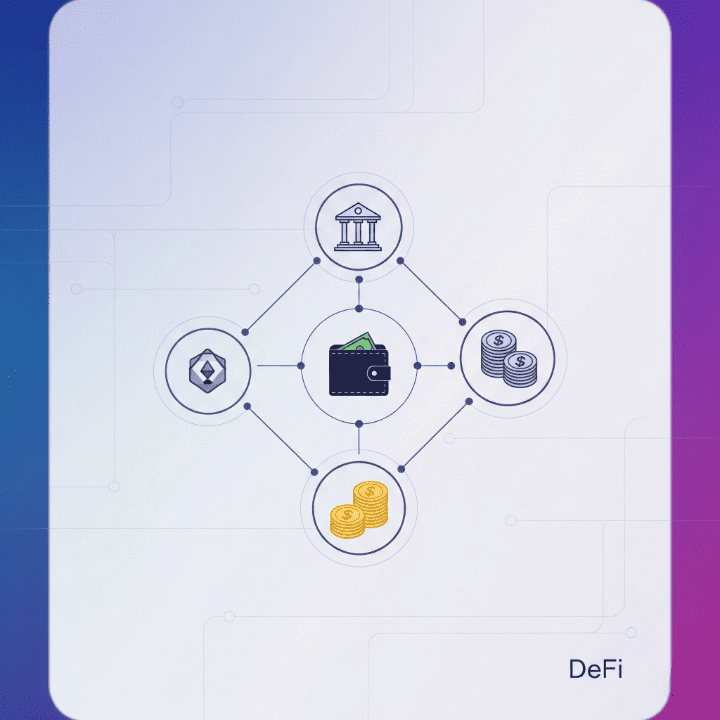
Introduction
The traditional financial system can feel restrictive and opaque. Banks, brokers, and other intermediaries control everything from loans and savings to trading and insurance. But a new world is emerging, one built on the principles of transparency and access: Decentralized Finance (DeFi). This rapidly growing ecosystem of financial applications is built on top of blockchain technology, primarily Ethereum, and aims to recreate traditional financial services in a decentralized way. For many, DeFi represents the next frontier of investing in crypto, offering a chance to earn higher yields and have greater control over their assets. However, this innovative space comes with unique risks. This comprehensive guide will demystify DeFi, explain how it works, explore its key applications, and provide essential tips for navigating this exciting but complex new financial world with a strong financial planning mindset.
What Exactly is Decentralized Finance (DeFi)?
DeFi is an umbrella term for financial applications and services that run on decentralized public blockchains. The key difference from traditional finance is the removal of intermediaries. Instead of a bank processing your loan or a broker handling your trades, smart contracts automate these processes. A smart contract is a self-executing contract with the terms of the agreement directly written into lines of code. The code runs on the blockchain, making the entire system transparent and immutable. This creates a peer-to-peer financial system where you have full control over your digital assets.
Key Concepts of the DeFi Ecosystem
To understand DeFi, you need to grasp a few core concepts that are foundational to the ecosystem.
1. Smart Contracts
As mentioned, smart contracts are the core building blocks of DeFi. They automate transactions and agreements without the need for a third party. For example, a loan agreement can be coded into a smart contract that automatically releases funds when collateral is provided and liquidates the collateral if a payment is missed.
2. DApps (Decentralized Applications)
DApps are applications built on a blockchain. They are similar to apps on your smartphone, but they run on a decentralized network rather than being controlled by a single company. Most DeFi services, such as lending protocols and decentralized exchanges, are DApps.
3. Yield Farming and Liquidity Pools
This is how many users earn passive income in DeFi. A liquidity pool is a collection of funds locked in a smart contract. Users provide their digital assets to these pools to facilitate trading on decentralized exchanges. In return, they receive a portion of the trading fees, and often, additional rewards in the form of a governance token. This process of chasing the highest yields is known as yield farming.
4. Oracles
DeFi applications often need to access real-world information, like asset prices or weather data, to execute their smart contracts. Oracles are services that provide this off-chain data to the blockchain in a secure and reliable way.
Major DeFi Applications and Services
The DeFi ecosystem is expanding rapidly, but a few key categories form its foundation.
1. Decentralized Exchanges (DEXs)
A DEX is a peer-to-peer cryptocurrency exchange where you trade directly with another user via a smart contract, without a central authority. Uniswap and PancakeSwap are two of the most popular DEXs. They are the primary way many users trade DeFi tokens.
2. Lending and Borrowing Protocols
Platforms like Aave and Compound allow users to lend out their crypto and earn interest. Other users can borrow from these pools, typically by providing collateral. This creates a decentralized market for loans where interest rates are algorithmically determined by supply and demand.
3. Stablecoins
Stablecoins are cryptocurrencies designed to minimize volatility. They are typically pegged to a stable asset, like the US dollar. They are essential for the DeFi ecosystem because they allow users to avoid the wild price swings of other cryptocurrencies while still participating in the decentralized ecosystem.
4. Insurance
DeFi also has its own insurance protocols, such as Nexus Mutual, which offer coverage for smart contract vulnerabilities and other DeFi-specific risks. This provides a new layer of protection for investors.
Key Risks of the DeFi World
DeFi offers incredible opportunities, but it is not without significant risk. Understanding these risks is crucial before you start investing in crypto in this space.
1. Smart Contract Risk
The code is king in DeFi, but if the code has a bug or a vulnerability, it can be exploited by hackers, leading to the permanent loss of funds. This is a constant threat and a major reason for caution.
2. Impermanent Loss
This risk is specific to liquidity providers on decentralized exchanges. Impermanent loss occurs when the price of the digital assets you provide to a liquidity pool changes relative to each other. This can result in a loss of value compared to simply holding the assets in your wallet.
3. Rug Pulls and Scams
The lack of regulation makes DeFi a breeding ground for scams. A “rug pull” is a type of scam where a project’s developers abandon the project and run off with investors’ funds. These are incredibly common in the DeFi space.
4. Price Volatility
While stablecoins exist, most DeFi assets are highly volatile. This can lead to rapid and significant losses, especially for those new to the space.
5. Regulatory Risk
The regulatory landscape for DeFi is still uncertain. Governments around the world are watching the space closely, and a sudden change in policy or a new law could have a major negative impact on the market.
Conclusion
Decentralized Finance is a revolutionary new frontier that is reshaping how we think about money and financial services. By removing intermediaries and automating processes with smart contracts, it offers a new level of transparency, efficiency, and access. For investors, it presents unique opportunities to earn passive income and have greater control over their digital assets. However, the space is still in its early stages and carries significant risks, including smart contract vulnerabilities, scams, and high volatility. A well-thought-out financial planning strategy in DeFi requires deep research, a strong understanding of risk management, and a commitment to staying informed. By approaching this new financial world with a balanced perspective, you can confidently explore its potential while protecting yourself from its pitfalls.


